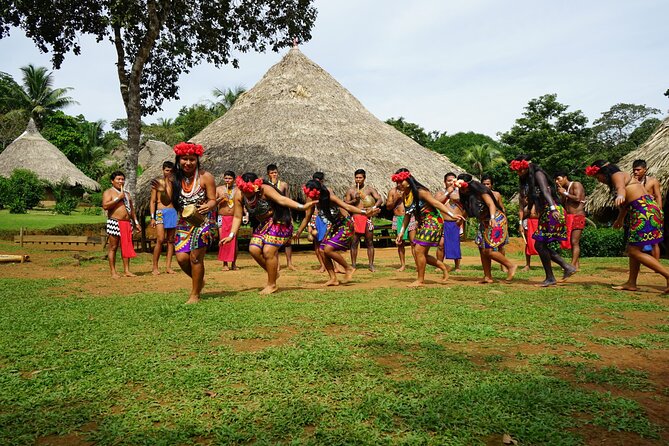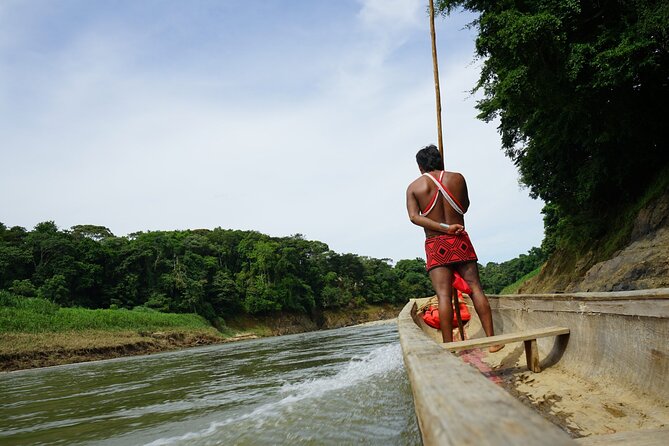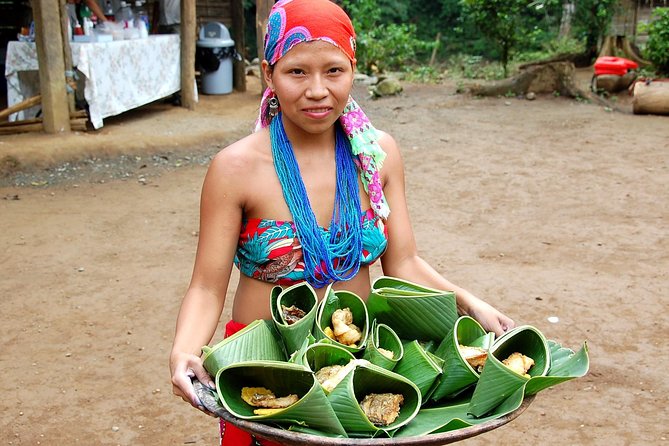Visiting the Embera Indian Village in Panama offers an unparalleled opportunity to take in a vibrant culture largely untouched by modern influences. Travelers can expect a warm welcome from the community, who take pride in sharing their rich heritage through captivating cultural exchanges. From intricate handicrafts to traditional dances, each encounter provides a deeper understanding of the Embera’s pre-Columbian history and way of life. Respectful engagement fosters meaningful connections, leaving visitors with a renewed appreciation for the resilience and traditions of this indigenous group. What secrets might this village hold, just waiting to be uncovered?
Good To Know

-
Visitors can experience Embera cultural heritage through a guided tour that includes a traditional welcome by the local chief and demonstrations of craft-making.
-
The tour provides opportunities to observe and participate in authentic Embera dances, gaining insights into their pre-Columbian history and connection to the land.
-
Engagement with skilled Embera artisans allows visitors to purchase handmade souvenirs, supporting the local community’s sustainability.
-
Emphasis on respectful exploration and open dialogue encourages a cultural exchange that fosters understanding of the Embera’s traditional way of life.
-
The tour is conducted within the lush setting of Chagres National Park, immersing visitors in the vibrant rhythms of Embera life within their jungle environment.
Overview of the Embera Indian Village Tour

Through a tour to an Embera village from Panama City, visitors can discover Panama’s indigenous heritage. The experience includes learning about the Embera’s proud, pre-Colombian history, traditional greetings from the local chief, and interactions with local artisans.
Guests travel by motorized dugout canoe upriver, following traditional trading routes into the jungle. Upon arrival, they’re welcomed with traditional Embera hospitality and can enjoy a series of dances.
Visitors are encouraged to explore the village, ask questions, and interact respectfully with the Embera people. The tour offers a glimpse into Panamanian life within the jungle of Chagres National Park.
You can also read our reviews of more tours and experiences in Panama City.
Tour Details and Itinerary
The Embera Indian Village tour lasts approximately 3 hours. Included in the tour are entrance fees, hotel pickup and drop-off, air-conditioned transportation, and a guided tour.
The tour starts at 8:00 am and involves traveling by motorized dugout canoe upriver, following traditional trading routes into the jungle. Upon arrival, visitors are welcomed with traditional Embera hospitality and can enjoy a series of dances.
Guests are encouraged to explore the village, interact respectfully with the Embera people, and purchase souvenirs from skilled local craftsmen. The tour offers a glimpse into Panamanian life within the Chagres National Park jungle.
Cultural Exchange and Interactions

Visitors are encouraged to explore the village and interact respectfully with the Embera people. The cultural exchange offers a glimpse into the traditional way of life.
Guests can watch skilled craftsmen produce beautiful handmade items, which are available for purchase as souvenirs. However, visitors should maintain sensitivity towards the community’s privacy and customs.
The village features a series of dances that showcase the Embera’s cultural heritage. By engaging with the locals, travelers can gain a deeper understanding of the Embera’s proud, pre-Columbian history and their connection to the surrounding jungle environment of Chagres National Park.
Exploring the Embera Village
Arriving via motorized dugout canoes, guests embark on a journey deep into the jungle, navigating the winding rivers and lush foliage of Chagres National Park.
Upon reaching the Embera village, visitors are welcomed with traditional hospitality and can explore the community’s way of life.
The village showcases skilled artisans crafting beautiful souvenirs, from intricately woven baskets to colorful wood carvings.
Guests are encouraged to interact respectfully, observing the community’s customs and traditions.
Through this cultural exchange, travelers gain a unique insight into the Embera’s proud, pre-Columbian heritage, seeing the vibrant rhythms of song and dance that define this indigenous way of life.
Purchasing Embera Crafts and Souvenirs
Embera craft-making stands as a cornerstone of the indigenous community’s cultural heritage, with skilled artisans showcasing their artistic talents throughout the village. Visitors can browse a wide array of handmade souvenirs, engaging directly with the creators and learning the stories behind their unique designs. The village’s craft selection includes:
| Item | Price Range |
|---|---|
| Woven Baskets | $10 – $50 |
| Traditional Jewelry | $5 – $25 |
| Carved Wood Figurines | $15 – $75 |
| Painted Textiles | $20 – $100 |
Purchasing these locally-produced crafts not only supports the Embera people but also serves as a tangible reminder of the rich cultural exchange experienced during the village tour.
Embera Hospitality and Traditional Dances
The Embera people warmly welcome visitors to their village, expressing their rich cultural heritage through a series of traditional dances.
Upon arrival, guests are greeted by the local chief and treated to an authentic display of Embera hospitality.
The villagers perform intricate dances, each with its own unique rhythm and meaning, showcasing their deep connection to the land and their ancestors.
As visitors observe and even participate in these captivating performances, they gain a deeper understanding of the Embera’s vibrant traditions and the importance of preserving their cultural identity within the Panamanian jungle.
Sensitivity and Respect for the Community

While the Embera people warmly welcome visitors to their village, it’s crucial that guests maintain sensitivity and respect for the community’s privacy and customs.
Visitors should be mindful of the following:
- Avoid intrusive photography or filming without explicit permission.
- Respect the Embera’s traditional way of life and refrain from imposing outside influences.
- Engage in open and respectful dialogue, showing genuine interest in their culture and traditions.
- Follow the guidance of the tour guides to ensure the visit is enriching for both parties.
Practical Information and Special Offers
For those interested in the Embera Indian Village tour, several practical details and special offers are available.
The tour involves moderate walking, so it’s not wheelchair accessible. Travelers can take advantage of the free cancellation policy up to 24 hours before the experience.
Currently, there’s a special offer price of $130.66, down from the original $139.00. Guests should note that children must be accompanied by an adult, and infants must sit on laps during the tour.
Frequently Asked Questions
How Do the Embera People Maintain Their Traditional Way of Life?
The Embera people maintain their traditional way of life by preserving their cultural practices, passing down skills and knowledge to younger generations, and living in remote villages within the jungle. They’ve resisted outside influences to protect their unique identity.
What Is the Significance of the Embera People’s Spiritual and Cultural Beliefs?
The Embera people’s spiritual and cultural beliefs are deeply rooted in their connection to the natural world. They’ve preserved traditions that reflect their respect for the land, ancestors, and community’s wellbeing, which are essential to their collective identity.
How Does the Embera Community Manage Environmental Conservation Efforts?
The Embera community actively manages environmental conservation efforts, working to protect the rainforest habitat they rely on. They use sustainable practices, promote ecotourism, and collaborate with authorities to safeguard the natural resources vital to their way of life.
What Are the Educational Opportunities Available for Embera Children?
Embera children typically attend village schools, where they learn their native language, traditions, and practical skills. Some also have the opportunity to receive higher education, though access can be limited due to the remote location of their villages.
What Are the Embera People’s Perspectives on Sustainable Tourism in Their Village?
The Embera people view sustainable tourism as a way to share their culture and generate income, but they also want to maintain their traditional way of life and privacy. They’re selective about the experiences they offer visitors.
The Sum Up
Visiting the Embera Indian Village offers a unique chance to connect with the local community and take in their vibrant culture. Engaging with skilled artisans, observing traditional dances, and learning about the Embera’s rich heritage promote a deeper appreciation and respect for their way of life. Responsible tourism supports the community and preserves their traditions, making the experience both meaningful and memorable.
More Tour Reviews in Panama City
Not for you? Here's more nearby things to do in Panama City we have reviewed
- 17 Best Guided Tours In Panama City
- 25 Best Tours In Panama City
- 4 Best Shopping Tours In Panama City
- 2 Best Shore Excursions In Panama City
- 2 Best National Park Tours In Panama City
- 3 Best Drinking Tours In Panama City
- Panama City Highlights Private Tour
- Day Trip to San Blas From Panama City
- Round Trip Transfer in Private Minivan From-To Tocumen Airport in Playa Blanca
- River Tubing Full Day Private Tour to the Chagres Park in Panama
- Romantic Camping in San Blas Islands
- Heli City Tour Over Panama
